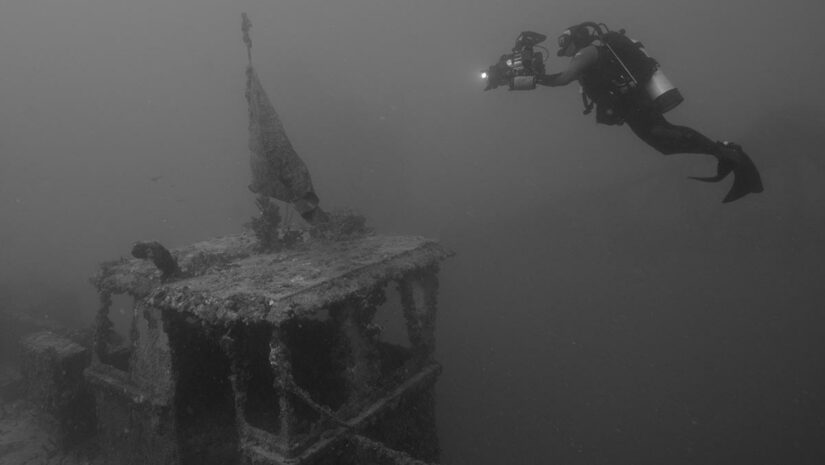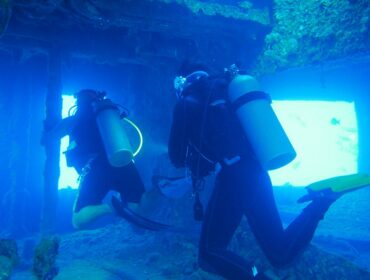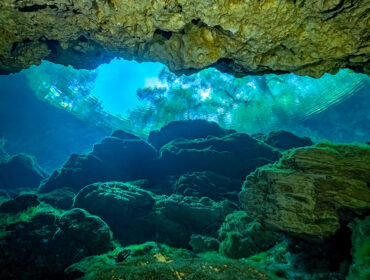Discover the exciting world of Spiegel Grove, an iconic artificial reef rich in history and marine life. This article digs into the unusual tale of this old Navy landing craft, including how it ended up in the Florida Keys. We will tell you all about the best methods to dive this massive wreck while exploring its numerous sections and features and navigating potential hazards. You will learn about the continuing conservation efforts aimed at protecting the Spiegel Grove and to conclude we will tell you about the required gear and equipment needed to dive the wreck safely.
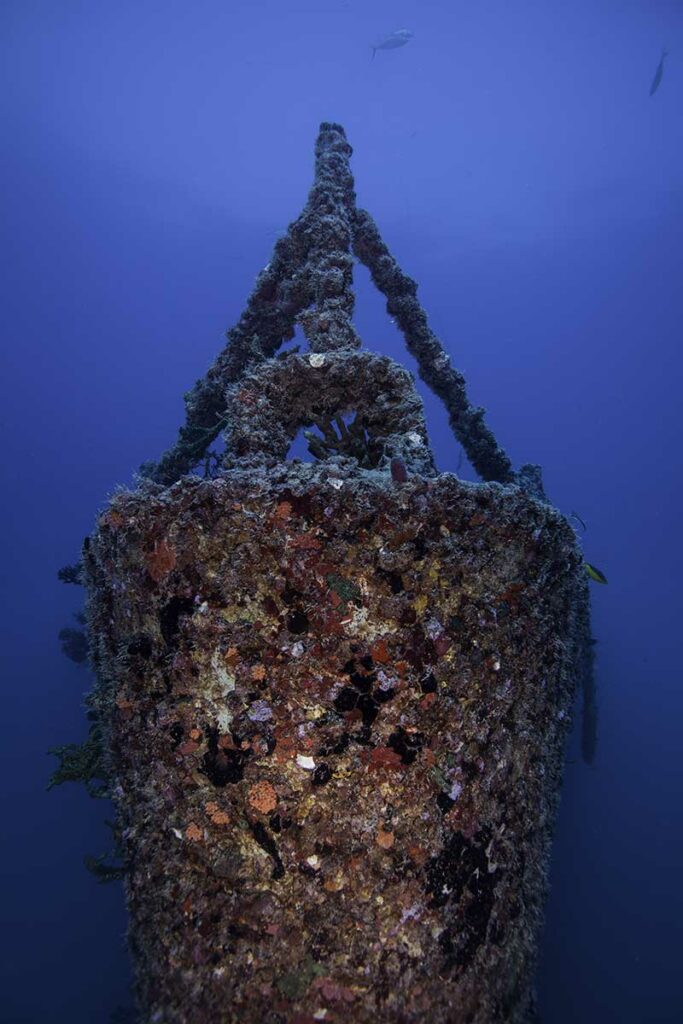
What is Spiegel Grove?
Spiegel Grove is a shipwreck at Key Largo, Florida, that was originally a US Navy Thomaston-class dock landing ship. The vessel, named for President Rutherford B. Hayes’ house, had a noteworthy service history before being transformed into an artificial reef. The ship was deliberately sunk in 2002, as planned by the state of Florida. The ship unexpectedly sank too quick during the sinking operation. As a result, it wound up on the ocean floor inverted, with the bow visible above the water. Hurricane Dennis, however, corrected this in 2005 by flipping the vessel to its intended position. The Spiegel Grove wreck has a depth range of 70 to 130 feet (21 to 40 meters), making it an intriguing dive within the Florida Keys National Marine Sanctuary.
History of Spiegel Grove
The USS Spiegel Grove’s operational life centered mostly around tactical operations off the east coast and in the Caribbean. The ship took part in several major tasks, including “Solant Amity II,” a goodwill mission transporting relief supplies along the African coast, and “Operation Steel Pike I” off the coast of Spain. It also aided the Mercury-Atlas 7 manned space flight. Spiegel Grove was decommissioned and placed in the James River “mothball” fleet in 1989.
The USS Spiegel Grove was turned into an artificial reef off the coast of Key Largo, Florida, in 2002, after a thorough cleaning and deliberate preparation for safe diving access. The ship was sunk by allowing water into her ballast tanks, but an unexpected premature sinking caused her to capsize. Despite the fact that she was lying on her starboard side, marine life began to colonize the structure, with corals, barnacles, sponges, and fish transforming it into a thriving ecosystem.
In an unexpected twist of fate, Hurricane Dennis in 2005 rolled the Spiegel Grove back into its proper upright position. Today, this thriving artificial reef is home to a big variety of marine species and serves as a unique and popular dive site, contributing to ocean conservation efforts and bolstering the local tourism industry.
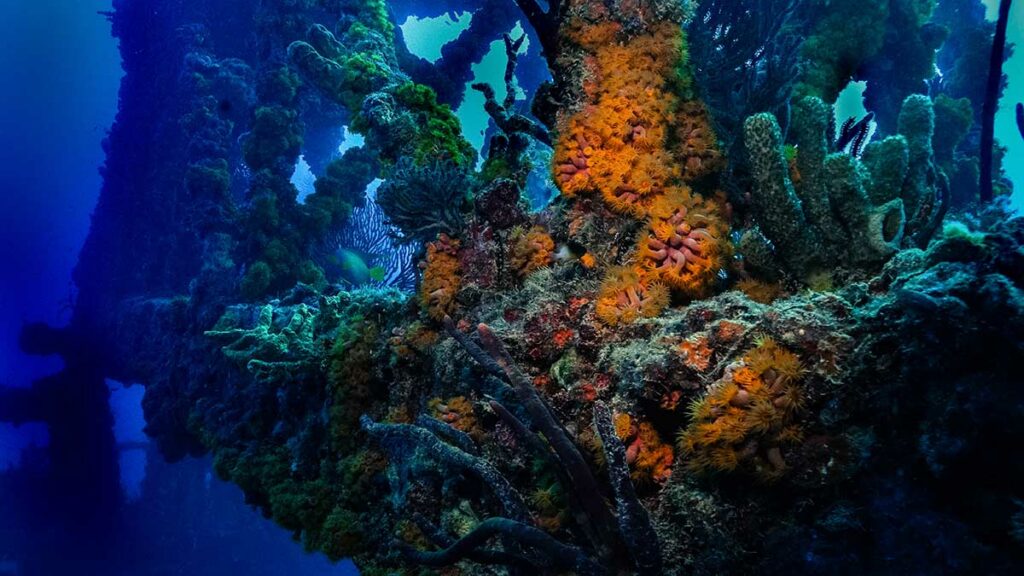
Diving into Spiegel Grove
The USS Spiegel Grove lies six miles off the Florida Keys, on Dixie Shoal. As it is six miles off the coast, you can only access it by boat. The wreck is located inside the Florida Keys National Marine Sanctuary, with the wreck’s top deck approximately 60 feet beneath the water’s surface, while its expansive hull reaches depths of 135 feet. The dive site is not suitable for beginner divers, and only divers holding an advanced certification (or higher) can dive the site.
GPS Coordinates of the Spiegel Grove: 25′ 0.63299′ N 80′ 22.367’W
The sheer magnitude of Spiegel Grove, with a length of 510 feet and width of 84 feet, makes it one of the most impressive dive sites in the Keys. It’s said that even after a hundred dives, divers may still discover unexplored sections of this artificial reef, which can sometimes disappear into a blue-green haze on less clear days. Divers can also get lost on the wreck, as it’s just so big.
Almost instantly following its sinking, Spiegel Grove became a beacon for marine life, attracting everything from large groupers to a schools of tropical fish. The wreck’s considerable size offers a more extensive habitat than any natural reef structure in the area. Coral growth has progressively enveloped the ship, fostering a vibrant ecosystem with thousands of species of fish and marine life
Clear days enable sights down to the sandy bottom at around 130 feet depth, while mooring buoys provide safe and environmentally acceptable boat tie-offs. Exploring Spiegel Grove delivers not only a one-of-a-kind diving experience, but also insight into nature’s transformational power over man-made structures.
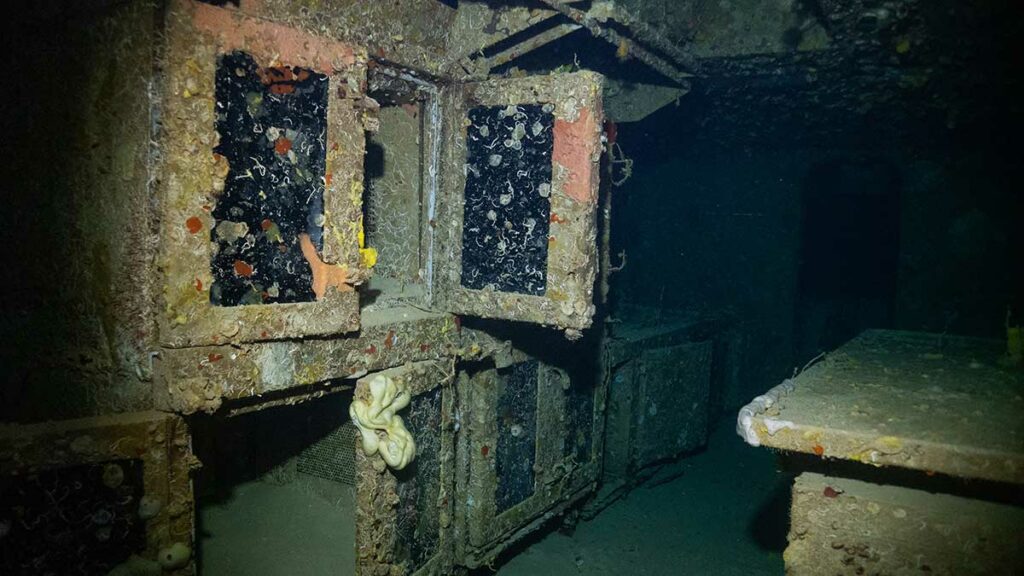
Exploring the Spiegel Grove Wreck
The Spiegel Grove wreck offers an incredible diving experience with its various sections and areas of interest. As one of the largest wrecks to become an artificial reef, it provides an awe-inspiring sight for divers of different experience levels. The wreck sits upright on the sandy bottom, with the bow accessible at around 95 feet and the stern at 80 feet. Most mooring lines are set at about 70 feet, allowing for easy access to different parts of the ship.
The wreck’s superstructure is designed with divers in mind, featuring swim-throughs at regular intervals. These passages offer a glimpse into the ship’s interior, where history and excitement collide. Inside the wreck, divers must exercise caution and proper training to avoid hazards and ensure their safety. The ship’s crane arms, adorned with colorful sponges and corals, make for stunning photography subjects. Divers can encounter an array of marine life while exploring the Spiegel Grove. Tropical reef fish fill the water column, while larger pelagic species roam the area. Barracudas, jacks, spadefish, sharks, Goliath grouper, queen angelfish, and nurse sharks are among the common inhabitants.
The wreck’s size makes it simply impossible to explorer the whole dive site in one dive, in fact – you would need at least 4 dives for a general total impression and even way more dives to really say you know your way around the wreck. Navigating the Spiegel Grove wreck poses some challenges and requires proper precautions. Divers must be advanced level certified due to the depths involved. Proper dive planning, understanding the currents, and using the wreck to their advantage are crucial to having a safe and enjoyable experience. It’s recommended to have a dive guide, who can lead you to the best spots and easy swim-throughs.
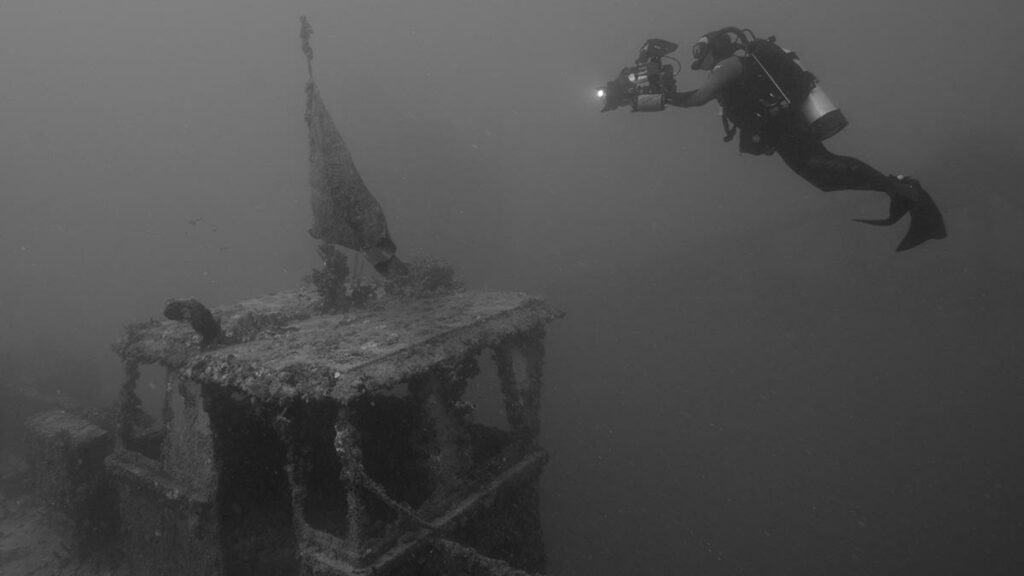
Safety Considerations
When diving the Spiegel Grove, safety is of the foremost importance. Divers must have advanced level certification due to the wreck’s depths. Regular diving experience and knowledge of wreck diving techniques are also essential.
Dive operators and guides play an important role in ensuring safety. They conduct thorough briefings covering entry, exit procedures, navigation, air management, and emergency protocols. Divers must pay close attention to these briefings and ask for clarification if needed. Emergency procedures should be well understood and reviewed before each dive. Divers should always have the required safety equipment with them, such as dive computers, lights, and signaling devices.
A safe dive requires effective air management. The rule of thirds is followed, with one-third of the air and time reserved for the return trip and emergencies. To avoid decompression sickness, it is critical to check air consumption and bottom time on a regular basis.
Penetration into the wreck is an intriguing experience, but comes with risks. Exploring closed chambers or tunnels requires proper training. Divers should never enter regions where they cannot see daylight at the exit or where they cannot be within close proximity of their diving buddy.
Hazards within the wreck, such as entanglement risks, demand cautious movement and a good buoyancy. Divers must be aware of surroundings to avoid accidents. Interactions with marine life should be conducted with respect and safety in mind. Divers must refrain from touching marine life and wreck structures and avoid collecting souvenirs.
Environmental Impact and Conservation Efforts
Artificial reefs, such as the Spiegel Grove, play a vital role in marine ecosystem conservation and restoration. These underwater structures provide habitat and shelter to a wide variety of marine creatures, promoting biodiversity and improving local ecosystems. Artificial reefs have a positive influence that extends beyond simply attracting marine life; they also provide chances for scientific research, education, and sustainable tourism.
As one of the largest artificial reefs, Spiegel Grove has become a vital hub for marine life in the Florida Keys. Its colorful sponges, corals, and algae-covered superstructure serves as a base for numerous crustaceans and fish species to thrive. The wreck attracts schools of tropical reef fish over time, providing a feeding site for predators such as barracudas and groupers.
To maintain the long-term viability of this artificial reef, conservation activities for the Spiegel Grove and its surrounds are continuing. Local groups, government agencies, and dive operators work together to put safety measures in place and encourage responsible diving practices. These initiatives include evaluating the wreck’s status on a regular basis, controlling diving activities, and raising public knowledge about the reef’s value and vulnerability.
Encouragement of responsible diving techniques among visitors and divers is an important part of conservation. Divers should avoid harming or destroying aquatic life or the wreck structure. It is critical to maintain the reef’s integrity by using buoyancy control to avoid contact with the delicate corals and sponges. Divers should also avoid dropping anchors on the reef, as this can cause significant damage.
Conservation efforts can include raising awareness about the negative consequences of marine debris and pollution. Divers are urged to take part in underwater cleanups to remove rubbish from the reef and its surrounds. Furthermore, responsible divers should reduce their carbon footprint by employing eco-friendly methods such as reef-safe sunscreen and reducing waste.
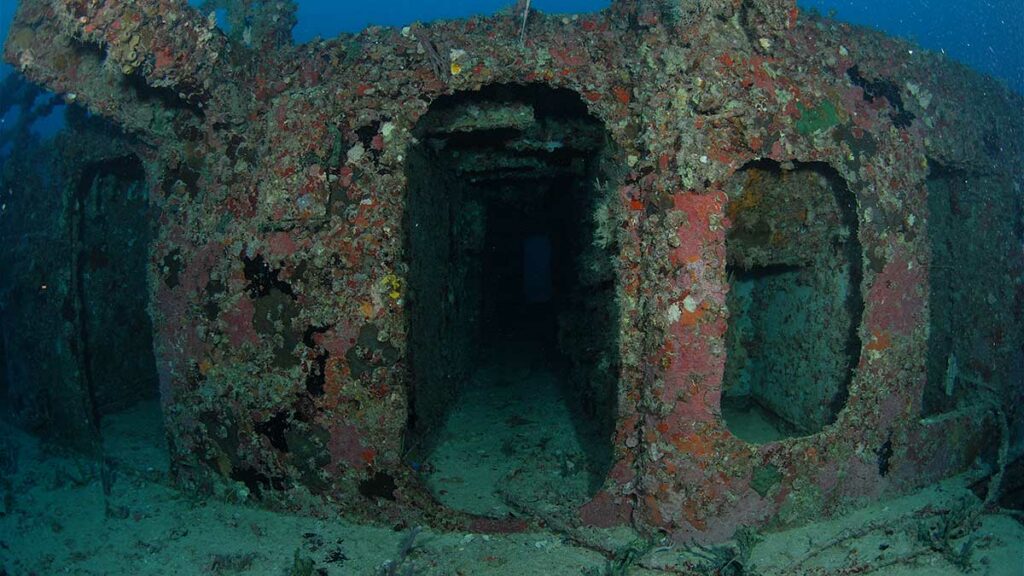
Tips for Diving Spiegel Grove
To make your dive successful we recommend that you pay close attention to the dive briefings, knowing exactly what to do and when. We also advice you to bring the right equipment, so that you can enhance your diving experience on the Spiegel Grove while ensuring your safety and protecting the marine environment. Equipment you should bring with you:
Surface Marker Buoy (SMB) and Whistle
Prioritize safety with a surface marker buoy and whistle. The SMB allows you to signal your position to the boat, making it easier for the crew to locate you after the dive. The whistle serves as an effective signaling device in emergencies.
Dive Light
Enhance your exploration of the wreck with a powerful underwater flashlight. The dive light improves visibility, especially in darker interior areas, allowing you to fully appreciate the details of the wreck.
Dive Knife
Carry a reliable dive knife to ensure preparedness for any entanglements or potential hazards during your dive. It serves as a valuable tool for cutting through fishing lines or ropes.
Underwater Slate
Facilitate communication with your dive buddy using an underwater slate. Jot down important notes, draw maps of the wreck, or simply communicate underwater for better coordination during the dive.
Thick Gloves
Protect your hands from sharp edges and rough surfaces on the wreck by wearing thick gloves. Durable and comfortable gloves will safeguard your hands while providing dexterity.
Wreck Line and Reel
If you plan to penetrate the wreck, a wreck line and reel are a must. These lines help guide your way out in reduced visibility, ensuring a safe and clear path back to the entry point.
Florida Fish ID Cards and Books
Enhance your dive experience by identifying the various Florida fish species you encounter. Carry fish ID cards or books to learn and recognize the diverse marine life thriving around the Spiegel Grove. Some of the Fish ID cards are waterproof and you can take them with you on the dive. Others, and the books, are better left on the surface to be enjoyed after you’ve finished the dives.
Conclusion
The Spiegel Grove in the Florida Keys is a lovely homage to history as well as a thriving marine life eco-system. Exploration of this gigantic artificial reef, with its abundant marine life and hidden secrets, is strongly suggested for advanced open water divers. We recommend doing at least two dives on the wreck if you have the time. If you’re a keen wreck diver, you might even consider planning more dives because it’s such a great wreck where you can appreciate both the wreck and all the fish and crustaceans that dwell on it.

